Nursing Research Report: Drug Preparation & Medication Processes
VerifiedAdded on 2022/09/18
|11
|3064
|17
Report
AI Summary
This report provides a detailed analysis of two nursing research papers. The first paper, 'Incorrect Drug Preparation for Patients with Feeding Tubes,' examines the challenges and potential errors in preparing medications for patients using feeding tubes, focusing on intervention programs to reduce errors. The second paper, 'Medication Administration Processes,' explores the challenges faced by registered nurses in medication administration, including factors related to medications, collaboration, work environment, education, and patient-related issues. The report compares the aims, methods, and results of both papers, critically reviewing their internal and external validity, and trustworthiness. The conclusion emphasizes the importance of systematic approaches, unbiased methods, and patient safety, highlighting the relevance of these studies in improving nursing practices and patient outcomes. The study also emphasizes the need for a fair use of methods and processes.
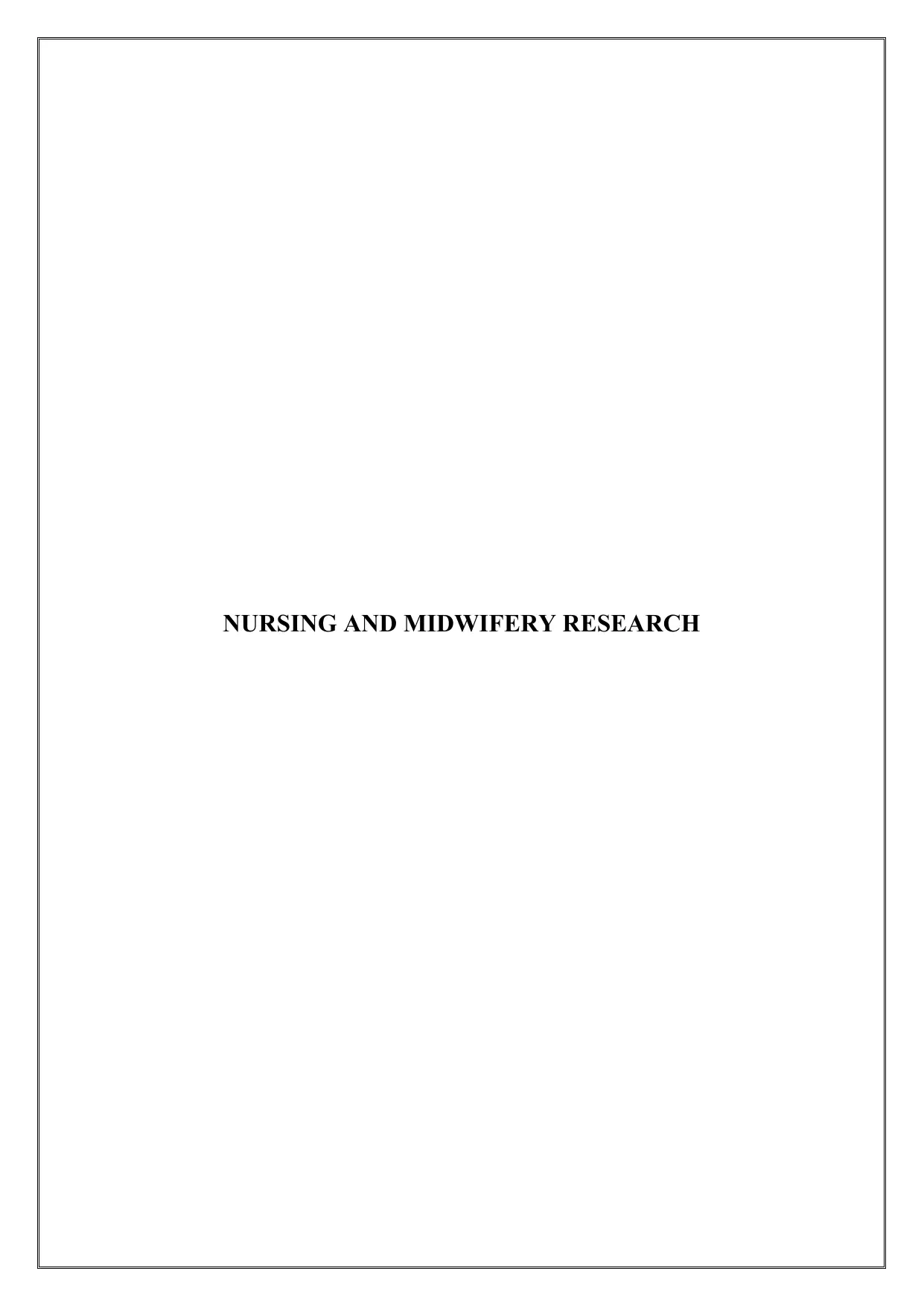
NURSING AND MIDWIFERY RESEARCH
Paraphrase This Document
Need a fresh take? Get an instant paraphrase of this document with our AI Paraphraser
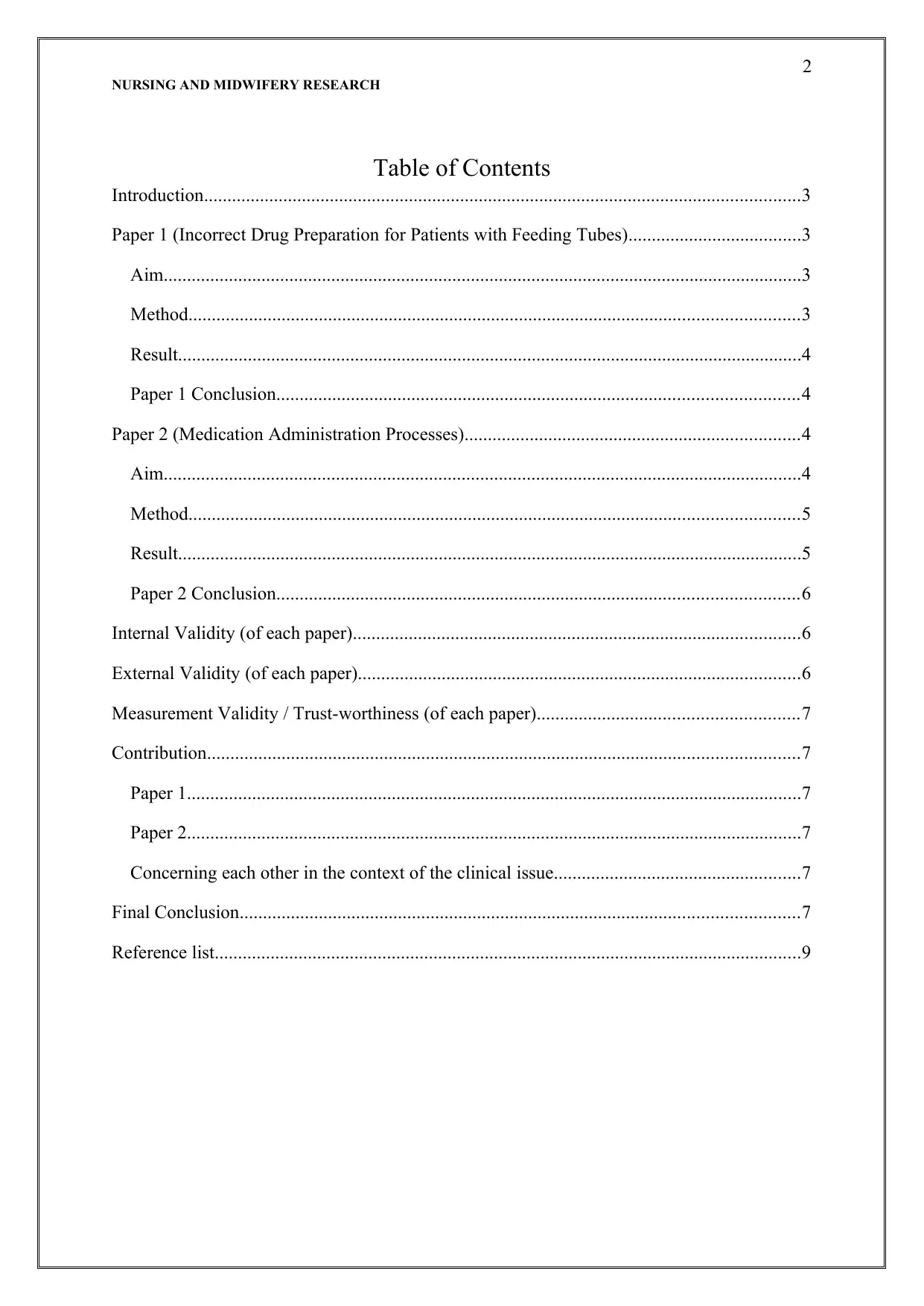
2
NURSING AND MIDWIFERY RESEARCH
Table of Contents
Introduction................................................................................................................................3
Paper 1 (Incorrect Drug Preparation for Patients with Feeding Tubes).....................................3
Aim.........................................................................................................................................3
Method...................................................................................................................................3
Result......................................................................................................................................4
Paper 1 Conclusion................................................................................................................4
Paper 2 (Medication Administration Processes)........................................................................4
Aim.........................................................................................................................................4
Method...................................................................................................................................5
Result......................................................................................................................................5
Paper 2 Conclusion................................................................................................................6
Internal Validity (of each paper)................................................................................................6
External Validity (of each paper)...............................................................................................6
Measurement Validity / Trust-worthiness (of each paper)........................................................7
Contribution...............................................................................................................................7
Paper 1....................................................................................................................................7
Paper 2....................................................................................................................................7
Concerning each other in the context of the clinical issue.....................................................7
Final Conclusion........................................................................................................................7
Reference list..............................................................................................................................9
NURSING AND MIDWIFERY RESEARCH
Table of Contents
Introduction................................................................................................................................3
Paper 1 (Incorrect Drug Preparation for Patients with Feeding Tubes).....................................3
Aim.........................................................................................................................................3
Method...................................................................................................................................3
Result......................................................................................................................................4
Paper 1 Conclusion................................................................................................................4
Paper 2 (Medication Administration Processes)........................................................................4
Aim.........................................................................................................................................4
Method...................................................................................................................................5
Result......................................................................................................................................5
Paper 2 Conclusion................................................................................................................6
Internal Validity (of each paper)................................................................................................6
External Validity (of each paper)...............................................................................................6
Measurement Validity / Trust-worthiness (of each paper)........................................................7
Contribution...............................................................................................................................7
Paper 1....................................................................................................................................7
Paper 2....................................................................................................................................7
Concerning each other in the context of the clinical issue.....................................................7
Final Conclusion........................................................................................................................7
Reference list..............................................................................................................................9
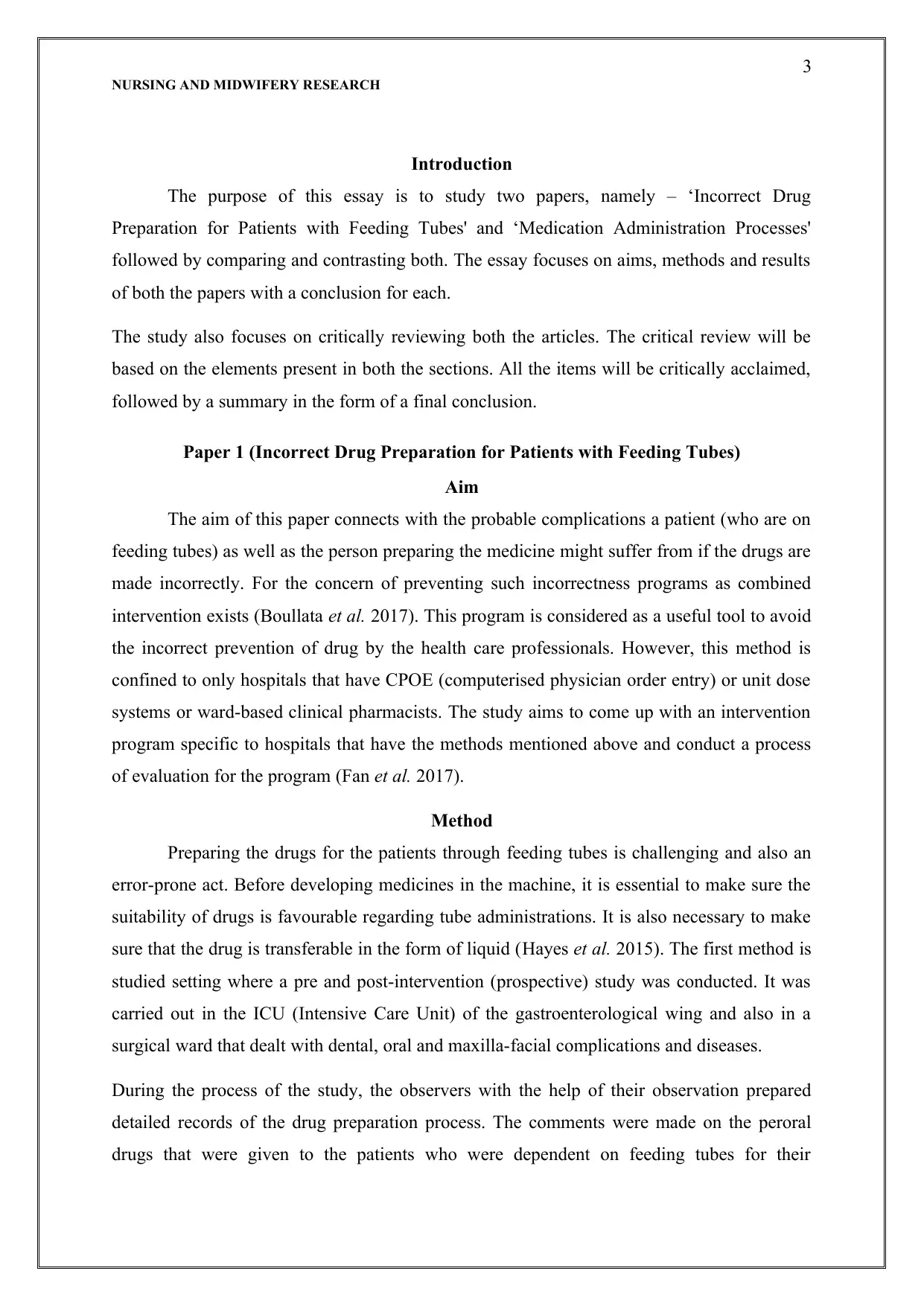
3
NURSING AND MIDWIFERY RESEARCH
Introduction
The purpose of this essay is to study two papers, namely – ‘Incorrect Drug
Preparation for Patients with Feeding Tubes' and ‘Medication Administration Processes'
followed by comparing and contrasting both. The essay focuses on aims, methods and results
of both the papers with a conclusion for each.
The study also focuses on critically reviewing both the articles. The critical review will be
based on the elements present in both the sections. All the items will be critically acclaimed,
followed by a summary in the form of a final conclusion.
Paper 1 (Incorrect Drug Preparation for Patients with Feeding Tubes)
Aim
The aim of this paper connects with the probable complications a patient (who are on
feeding tubes) as well as the person preparing the medicine might suffer from if the drugs are
made incorrectly. For the concern of preventing such incorrectness programs as combined
intervention exists (Boullata et al. 2017). This program is considered as a useful tool to avoid
the incorrect prevention of drug by the health care professionals. However, this method is
confined to only hospitals that have CPOE (computerised physician order entry) or unit dose
systems or ward-based clinical pharmacists. The study aims to come up with an intervention
program specific to hospitals that have the methods mentioned above and conduct a process
of evaluation for the program (Fan et al. 2017).
Method
Preparing the drugs for the patients through feeding tubes is challenging and also an
error-prone act. Before developing medicines in the machine, it is essential to make sure the
suitability of drugs is favourable regarding tube administrations. It is also necessary to make
sure that the drug is transferable in the form of liquid (Hayes et al. 2015). The first method is
studied setting where a pre and post-intervention (prospective) study was conducted. It was
carried out in the ICU (Intensive Care Unit) of the gastroenterological wing and also in a
surgical ward that dealt with dental, oral and maxilla-facial complications and diseases.
During the process of the study, the observers with the help of their observation prepared
detailed records of the drug preparation process. The comments were made on the peroral
drugs that were given to the patients who were dependent on feeding tubes for their
NURSING AND MIDWIFERY RESEARCH
Introduction
The purpose of this essay is to study two papers, namely – ‘Incorrect Drug
Preparation for Patients with Feeding Tubes' and ‘Medication Administration Processes'
followed by comparing and contrasting both. The essay focuses on aims, methods and results
of both the papers with a conclusion for each.
The study also focuses on critically reviewing both the articles. The critical review will be
based on the elements present in both the sections. All the items will be critically acclaimed,
followed by a summary in the form of a final conclusion.
Paper 1 (Incorrect Drug Preparation for Patients with Feeding Tubes)
Aim
The aim of this paper connects with the probable complications a patient (who are on
feeding tubes) as well as the person preparing the medicine might suffer from if the drugs are
made incorrectly. For the concern of preventing such incorrectness programs as combined
intervention exists (Boullata et al. 2017). This program is considered as a useful tool to avoid
the incorrect prevention of drug by the health care professionals. However, this method is
confined to only hospitals that have CPOE (computerised physician order entry) or unit dose
systems or ward-based clinical pharmacists. The study aims to come up with an intervention
program specific to hospitals that have the methods mentioned above and conduct a process
of evaluation for the program (Fan et al. 2017).
Method
Preparing the drugs for the patients through feeding tubes is challenging and also an
error-prone act. Before developing medicines in the machine, it is essential to make sure the
suitability of drugs is favourable regarding tube administrations. It is also necessary to make
sure that the drug is transferable in the form of liquid (Hayes et al. 2015). The first method is
studied setting where a pre and post-intervention (prospective) study was conducted. It was
carried out in the ICU (Intensive Care Unit) of the gastroenterological wing and also in a
surgical ward that dealt with dental, oral and maxilla-facial complications and diseases.
During the process of the study, the observers with the help of their observation prepared
detailed records of the drug preparation process. The comments were made on the peroral
drugs that were given to the patients who were dependent on feeding tubes for their
⊘ This is a preview!⊘
Do you want full access?
Subscribe today to unlock all pages.

Trusted by 1+ million students worldwide
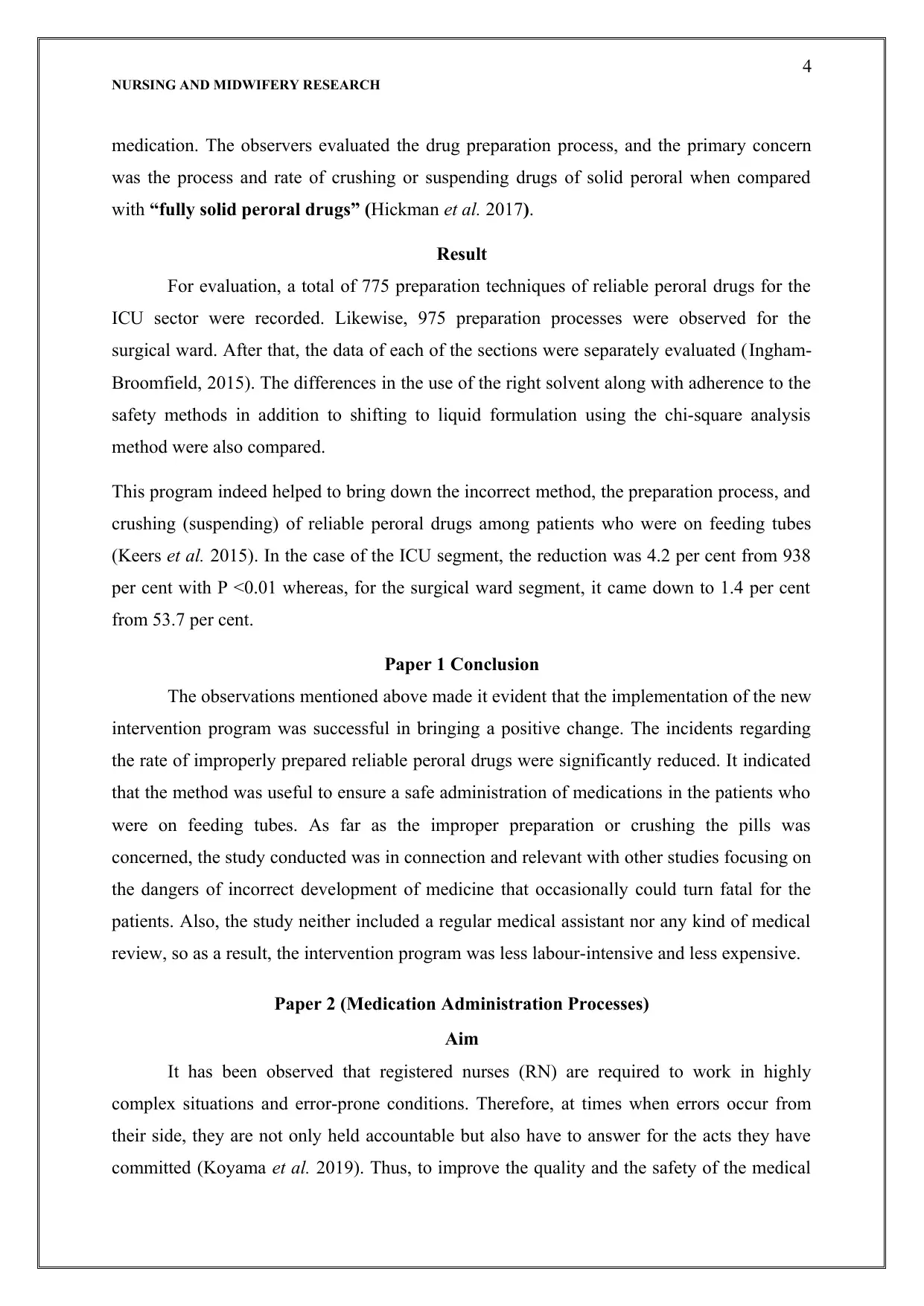
4
NURSING AND MIDWIFERY RESEARCH
medication. The observers evaluated the drug preparation process, and the primary concern
was the process and rate of crushing or suspending drugs of solid peroral when compared
with “fully solid peroral drugs” (Hickman et al. 2017).
Result
For evaluation, a total of 775 preparation techniques of reliable peroral drugs for the
ICU sector were recorded. Likewise, 975 preparation processes were observed for the
surgical ward. After that, the data of each of the sections were separately evaluated (Ingham-
Broomfield, 2015). The differences in the use of the right solvent along with adherence to the
safety methods in addition to shifting to liquid formulation using the chi-square analysis
method were also compared.
This program indeed helped to bring down the incorrect method, the preparation process, and
crushing (suspending) of reliable peroral drugs among patients who were on feeding tubes
(Keers et al. 2015). In the case of the ICU segment, the reduction was 4.2 per cent from 938
per cent with P <0.01 whereas, for the surgical ward segment, it came down to 1.4 per cent
from 53.7 per cent.
Paper 1 Conclusion
The observations mentioned above made it evident that the implementation of the new
intervention program was successful in bringing a positive change. The incidents regarding
the rate of improperly prepared reliable peroral drugs were significantly reduced. It indicated
that the method was useful to ensure a safe administration of medications in the patients who
were on feeding tubes. As far as the improper preparation or crushing the pills was
concerned, the study conducted was in connection and relevant with other studies focusing on
the dangers of incorrect development of medicine that occasionally could turn fatal for the
patients. Also, the study neither included a regular medical assistant nor any kind of medical
review, so as a result, the intervention program was less labour-intensive and less expensive.
Paper 2 (Medication Administration Processes)
Aim
It has been observed that registered nurses (RN) are required to work in highly
complex situations and error-prone conditions. Therefore, at times when errors occur from
their side, they are not only held accountable but also have to answer for the acts they have
committed (Koyama et al. 2019). Thus, to improve the quality and the safety of the medical
NURSING AND MIDWIFERY RESEARCH
medication. The observers evaluated the drug preparation process, and the primary concern
was the process and rate of crushing or suspending drugs of solid peroral when compared
with “fully solid peroral drugs” (Hickman et al. 2017).
Result
For evaluation, a total of 775 preparation techniques of reliable peroral drugs for the
ICU sector were recorded. Likewise, 975 preparation processes were observed for the
surgical ward. After that, the data of each of the sections were separately evaluated (Ingham-
Broomfield, 2015). The differences in the use of the right solvent along with adherence to the
safety methods in addition to shifting to liquid formulation using the chi-square analysis
method were also compared.
This program indeed helped to bring down the incorrect method, the preparation process, and
crushing (suspending) of reliable peroral drugs among patients who were on feeding tubes
(Keers et al. 2015). In the case of the ICU segment, the reduction was 4.2 per cent from 938
per cent with P <0.01 whereas, for the surgical ward segment, it came down to 1.4 per cent
from 53.7 per cent.
Paper 1 Conclusion
The observations mentioned above made it evident that the implementation of the new
intervention program was successful in bringing a positive change. The incidents regarding
the rate of improperly prepared reliable peroral drugs were significantly reduced. It indicated
that the method was useful to ensure a safe administration of medications in the patients who
were on feeding tubes. As far as the improper preparation or crushing the pills was
concerned, the study conducted was in connection and relevant with other studies focusing on
the dangers of incorrect development of medicine that occasionally could turn fatal for the
patients. Also, the study neither included a regular medical assistant nor any kind of medical
review, so as a result, the intervention program was less labour-intensive and less expensive.
Paper 2 (Medication Administration Processes)
Aim
It has been observed that registered nurses (RN) are required to work in highly
complex situations and error-prone conditions. Therefore, at times when errors occur from
their side, they are not only held accountable but also have to answer for the acts they have
committed (Koyama et al. 2019). Thus, to improve the quality and the safety of the medical
Paraphrase This Document
Need a fresh take? Get an instant paraphrase of this document with our AI Paraphraser
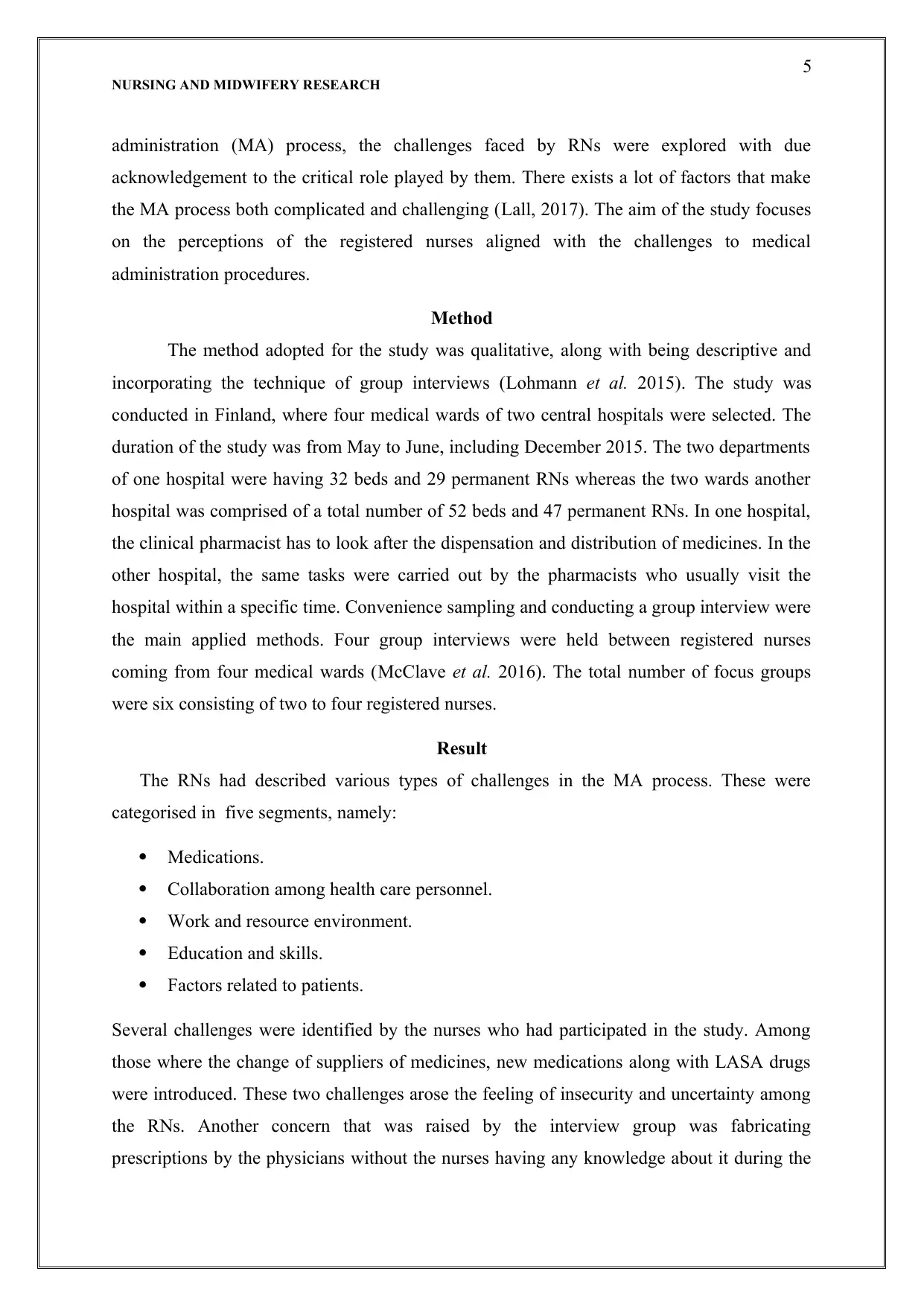
5
NURSING AND MIDWIFERY RESEARCH
administration (MA) process, the challenges faced by RNs were explored with due
acknowledgement to the critical role played by them. There exists a lot of factors that make
the MA process both complicated and challenging (Lall, 2017). The aim of the study focuses
on the perceptions of the registered nurses aligned with the challenges to medical
administration procedures.
Method
The method adopted for the study was qualitative, along with being descriptive and
incorporating the technique of group interviews (Lohmann et al. 2015). The study was
conducted in Finland, where four medical wards of two central hospitals were selected. The
duration of the study was from May to June, including December 2015. The two departments
of one hospital were having 32 beds and 29 permanent RNs whereas the two wards another
hospital was comprised of a total number of 52 beds and 47 permanent RNs. In one hospital,
the clinical pharmacist has to look after the dispensation and distribution of medicines. In the
other hospital, the same tasks were carried out by the pharmacists who usually visit the
hospital within a specific time. Convenience sampling and conducting a group interview were
the main applied methods. Four group interviews were held between registered nurses
coming from four medical wards (McClave et al. 2016). The total number of focus groups
were six consisting of two to four registered nurses.
Result
The RNs had described various types of challenges in the MA process. These were
categorised in five segments, namely:
Medications.
Collaboration among health care personnel.
Work and resource environment.
Education and skills.
Factors related to patients.
Several challenges were identified by the nurses who had participated in the study. Among
those where the change of suppliers of medicines, new medications along with LASA drugs
were introduced. These two challenges arose the feeling of insecurity and uncertainty among
the RNs. Another concern that was raised by the interview group was fabricating
prescriptions by the physicians without the nurses having any knowledge about it during the
NURSING AND MIDWIFERY RESEARCH
administration (MA) process, the challenges faced by RNs were explored with due
acknowledgement to the critical role played by them. There exists a lot of factors that make
the MA process both complicated and challenging (Lall, 2017). The aim of the study focuses
on the perceptions of the registered nurses aligned with the challenges to medical
administration procedures.
Method
The method adopted for the study was qualitative, along with being descriptive and
incorporating the technique of group interviews (Lohmann et al. 2015). The study was
conducted in Finland, where four medical wards of two central hospitals were selected. The
duration of the study was from May to June, including December 2015. The two departments
of one hospital were having 32 beds and 29 permanent RNs whereas the two wards another
hospital was comprised of a total number of 52 beds and 47 permanent RNs. In one hospital,
the clinical pharmacist has to look after the dispensation and distribution of medicines. In the
other hospital, the same tasks were carried out by the pharmacists who usually visit the
hospital within a specific time. Convenience sampling and conducting a group interview were
the main applied methods. Four group interviews were held between registered nurses
coming from four medical wards (McClave et al. 2016). The total number of focus groups
were six consisting of two to four registered nurses.
Result
The RNs had described various types of challenges in the MA process. These were
categorised in five segments, namely:
Medications.
Collaboration among health care personnel.
Work and resource environment.
Education and skills.
Factors related to patients.
Several challenges were identified by the nurses who had participated in the study. Among
those where the change of suppliers of medicines, new medications along with LASA drugs
were introduced. These two challenges arose the feeling of insecurity and uncertainty among
the RNs. Another concern that was raised by the interview group was fabricating
prescriptions by the physicians without the nurses having any knowledge about it during the
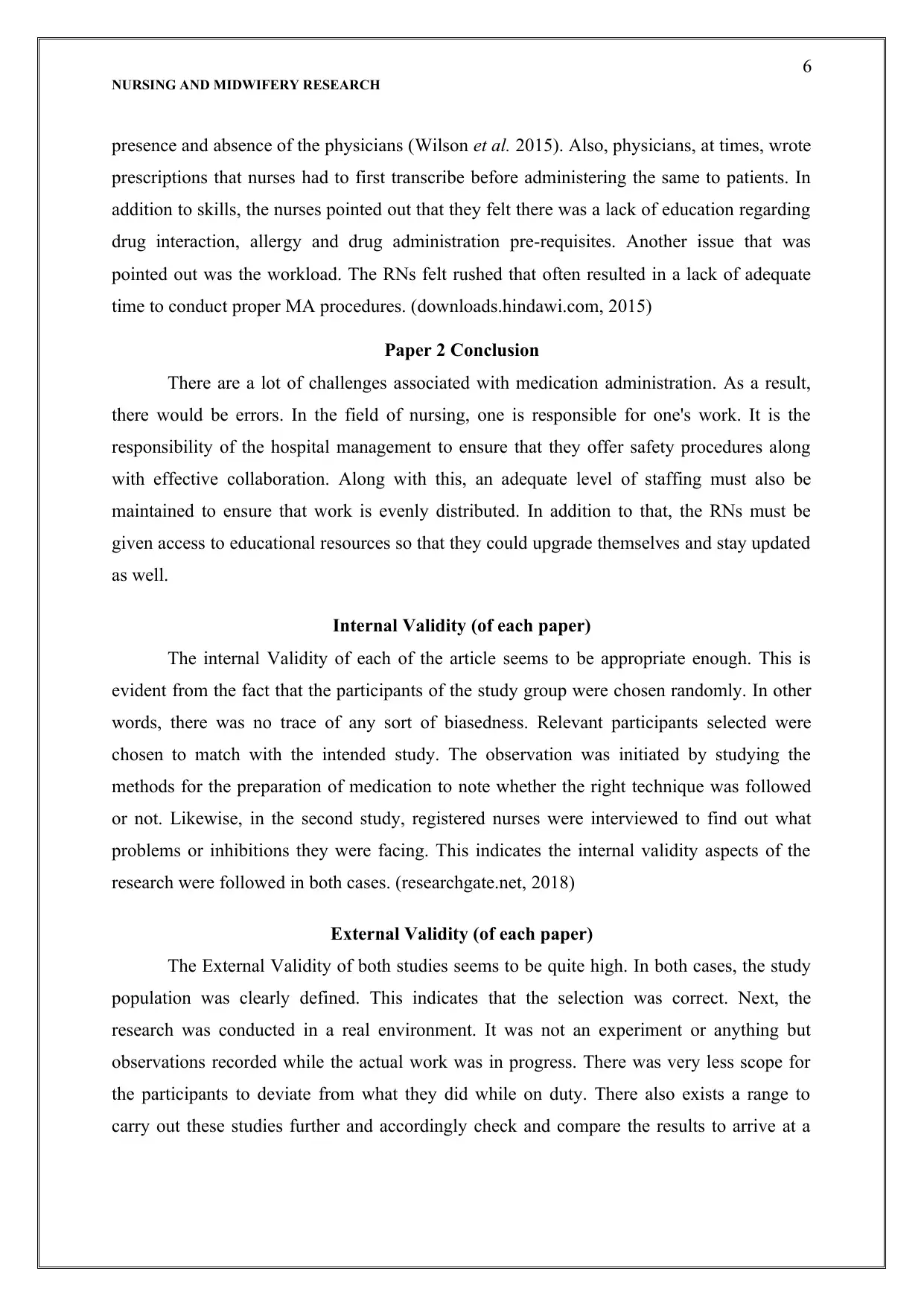
6
NURSING AND MIDWIFERY RESEARCH
presence and absence of the physicians (Wilson et al. 2015). Also, physicians, at times, wrote
prescriptions that nurses had to first transcribe before administering the same to patients. In
addition to skills, the nurses pointed out that they felt there was a lack of education regarding
drug interaction, allergy and drug administration pre-requisites. Another issue that was
pointed out was the workload. The RNs felt rushed that often resulted in a lack of adequate
time to conduct proper MA procedures. (downloads.hindawi.com, 2015)
Paper 2 Conclusion
There are a lot of challenges associated with medication administration. As a result,
there would be errors. In the field of nursing, one is responsible for one's work. It is the
responsibility of the hospital management to ensure that they offer safety procedures along
with effective collaboration. Along with this, an adequate level of staffing must also be
maintained to ensure that work is evenly distributed. In addition to that, the RNs must be
given access to educational resources so that they could upgrade themselves and stay updated
as well.
Internal Validity (of each paper)
The internal Validity of each of the article seems to be appropriate enough. This is
evident from the fact that the participants of the study group were chosen randomly. In other
words, there was no trace of any sort of biasedness. Relevant participants selected were
chosen to match with the intended study. The observation was initiated by studying the
methods for the preparation of medication to note whether the right technique was followed
or not. Likewise, in the second study, registered nurses were interviewed to find out what
problems or inhibitions they were facing. This indicates the internal validity aspects of the
research were followed in both cases. (researchgate.net, 2018)
External Validity (of each paper)
The External Validity of both studies seems to be quite high. In both cases, the study
population was clearly defined. This indicates that the selection was correct. Next, the
research was conducted in a real environment. It was not an experiment or anything but
observations recorded while the actual work was in progress. There was very less scope for
the participants to deviate from what they did while on duty. There also exists a range to
carry out these studies further and accordingly check and compare the results to arrive at a
NURSING AND MIDWIFERY RESEARCH
presence and absence of the physicians (Wilson et al. 2015). Also, physicians, at times, wrote
prescriptions that nurses had to first transcribe before administering the same to patients. In
addition to skills, the nurses pointed out that they felt there was a lack of education regarding
drug interaction, allergy and drug administration pre-requisites. Another issue that was
pointed out was the workload. The RNs felt rushed that often resulted in a lack of adequate
time to conduct proper MA procedures. (downloads.hindawi.com, 2015)
Paper 2 Conclusion
There are a lot of challenges associated with medication administration. As a result,
there would be errors. In the field of nursing, one is responsible for one's work. It is the
responsibility of the hospital management to ensure that they offer safety procedures along
with effective collaboration. Along with this, an adequate level of staffing must also be
maintained to ensure that work is evenly distributed. In addition to that, the RNs must be
given access to educational resources so that they could upgrade themselves and stay updated
as well.
Internal Validity (of each paper)
The internal Validity of each of the article seems to be appropriate enough. This is
evident from the fact that the participants of the study group were chosen randomly. In other
words, there was no trace of any sort of biasedness. Relevant participants selected were
chosen to match with the intended study. The observation was initiated by studying the
methods for the preparation of medication to note whether the right technique was followed
or not. Likewise, in the second study, registered nurses were interviewed to find out what
problems or inhibitions they were facing. This indicates the internal validity aspects of the
research were followed in both cases. (researchgate.net, 2018)
External Validity (of each paper)
The External Validity of both studies seems to be quite high. In both cases, the study
population was clearly defined. This indicates that the selection was correct. Next, the
research was conducted in a real environment. It was not an experiment or anything but
observations recorded while the actual work was in progress. There was very less scope for
the participants to deviate from what they did while on duty. There also exists a range to
carry out these studies further and accordingly check and compare the results to arrive at a
⊘ This is a preview!⊘
Do you want full access?
Subscribe today to unlock all pages.

Trusted by 1+ million students worldwide
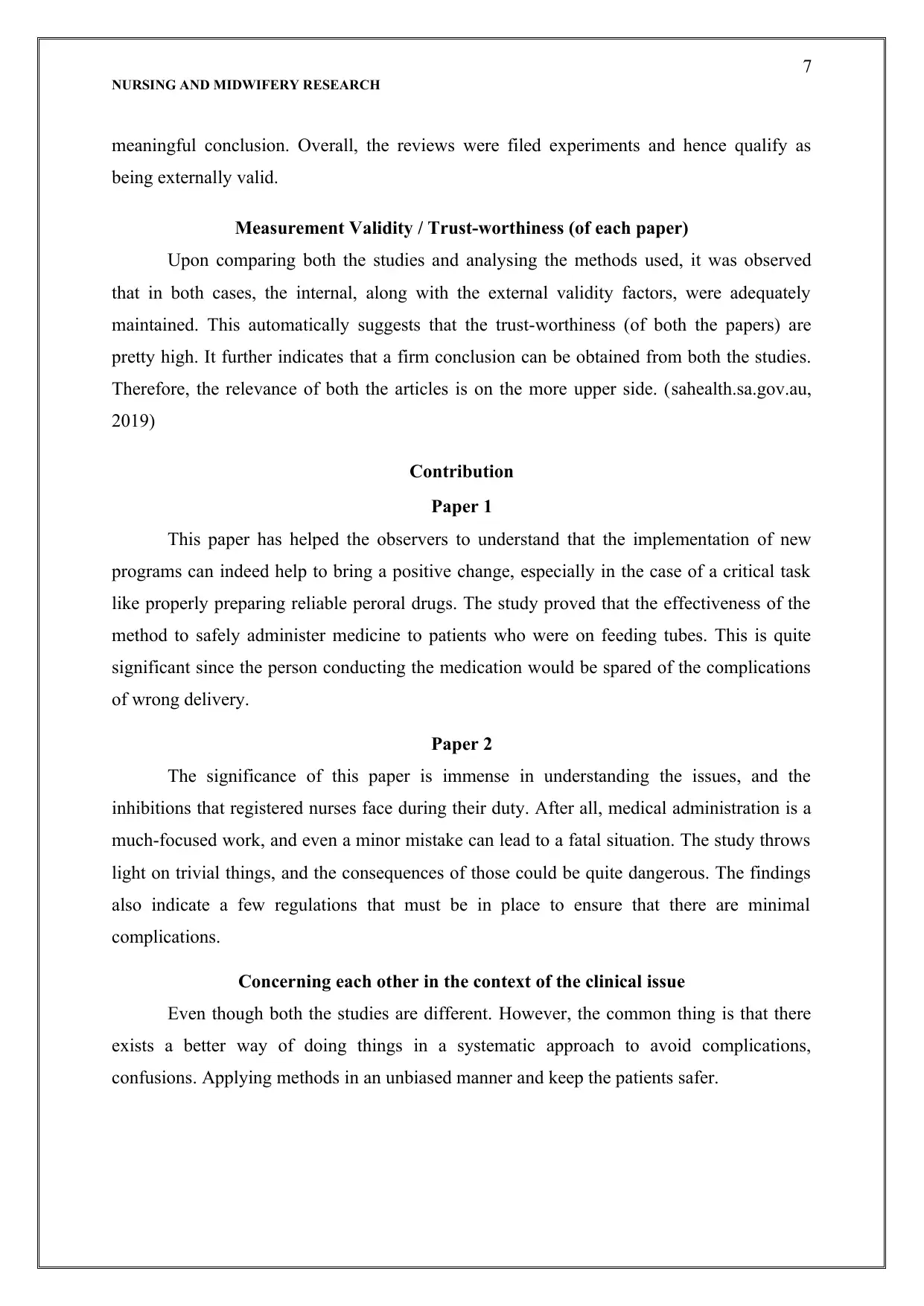
7
NURSING AND MIDWIFERY RESEARCH
meaningful conclusion. Overall, the reviews were filed experiments and hence qualify as
being externally valid.
Measurement Validity / Trust-worthiness (of each paper)
Upon comparing both the studies and analysing the methods used, it was observed
that in both cases, the internal, along with the external validity factors, were adequately
maintained. This automatically suggests that the trust-worthiness (of both the papers) are
pretty high. It further indicates that a firm conclusion can be obtained from both the studies.
Therefore, the relevance of both the articles is on the more upper side. (sahealth.sa.gov.au,
2019)
Contribution
Paper 1
This paper has helped the observers to understand that the implementation of new
programs can indeed help to bring a positive change, especially in the case of a critical task
like properly preparing reliable peroral drugs. The study proved that the effectiveness of the
method to safely administer medicine to patients who were on feeding tubes. This is quite
significant since the person conducting the medication would be spared of the complications
of wrong delivery.
Paper 2
The significance of this paper is immense in understanding the issues, and the
inhibitions that registered nurses face during their duty. After all, medical administration is a
much-focused work, and even a minor mistake can lead to a fatal situation. The study throws
light on trivial things, and the consequences of those could be quite dangerous. The findings
also indicate a few regulations that must be in place to ensure that there are minimal
complications.
Concerning each other in the context of the clinical issue
Even though both the studies are different. However, the common thing is that there
exists a better way of doing things in a systematic approach to avoid complications,
confusions. Applying methods in an unbiased manner and keep the patients safer.
NURSING AND MIDWIFERY RESEARCH
meaningful conclusion. Overall, the reviews were filed experiments and hence qualify as
being externally valid.
Measurement Validity / Trust-worthiness (of each paper)
Upon comparing both the studies and analysing the methods used, it was observed
that in both cases, the internal, along with the external validity factors, were adequately
maintained. This automatically suggests that the trust-worthiness (of both the papers) are
pretty high. It further indicates that a firm conclusion can be obtained from both the studies.
Therefore, the relevance of both the articles is on the more upper side. (sahealth.sa.gov.au,
2019)
Contribution
Paper 1
This paper has helped the observers to understand that the implementation of new
programs can indeed help to bring a positive change, especially in the case of a critical task
like properly preparing reliable peroral drugs. The study proved that the effectiveness of the
method to safely administer medicine to patients who were on feeding tubes. This is quite
significant since the person conducting the medication would be spared of the complications
of wrong delivery.
Paper 2
The significance of this paper is immense in understanding the issues, and the
inhibitions that registered nurses face during their duty. After all, medical administration is a
much-focused work, and even a minor mistake can lead to a fatal situation. The study throws
light on trivial things, and the consequences of those could be quite dangerous. The findings
also indicate a few regulations that must be in place to ensure that there are minimal
complications.
Concerning each other in the context of the clinical issue
Even though both the studies are different. However, the common thing is that there
exists a better way of doing things in a systematic approach to avoid complications,
confusions. Applying methods in an unbiased manner and keep the patients safer.
Paraphrase This Document
Need a fresh take? Get an instant paraphrase of this document with our AI Paraphraser
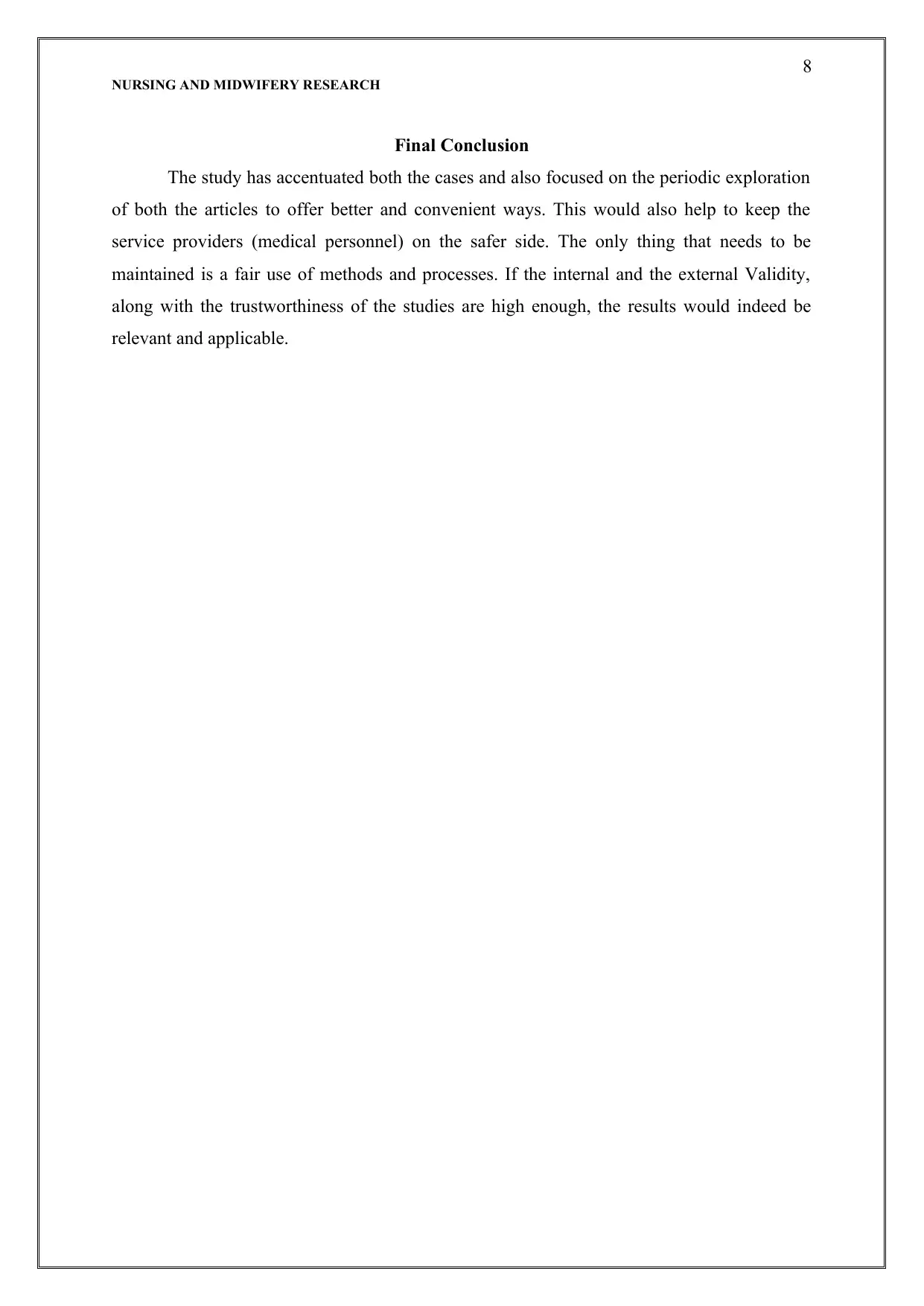
8
NURSING AND MIDWIFERY RESEARCH
Final Conclusion
The study has accentuated both the cases and also focused on the periodic exploration
of both the articles to offer better and convenient ways. This would also help to keep the
service providers (medical personnel) on the safer side. The only thing that needs to be
maintained is a fair use of methods and processes. If the internal and the external Validity,
along with the trustworthiness of the studies are high enough, the results would indeed be
relevant and applicable.
NURSING AND MIDWIFERY RESEARCH
Final Conclusion
The study has accentuated both the cases and also focused on the periodic exploration
of both the articles to offer better and convenient ways. This would also help to keep the
service providers (medical personnel) on the safer side. The only thing that needs to be
maintained is a fair use of methods and processes. If the internal and the external Validity,
along with the trustworthiness of the studies are high enough, the results would indeed be
relevant and applicable.
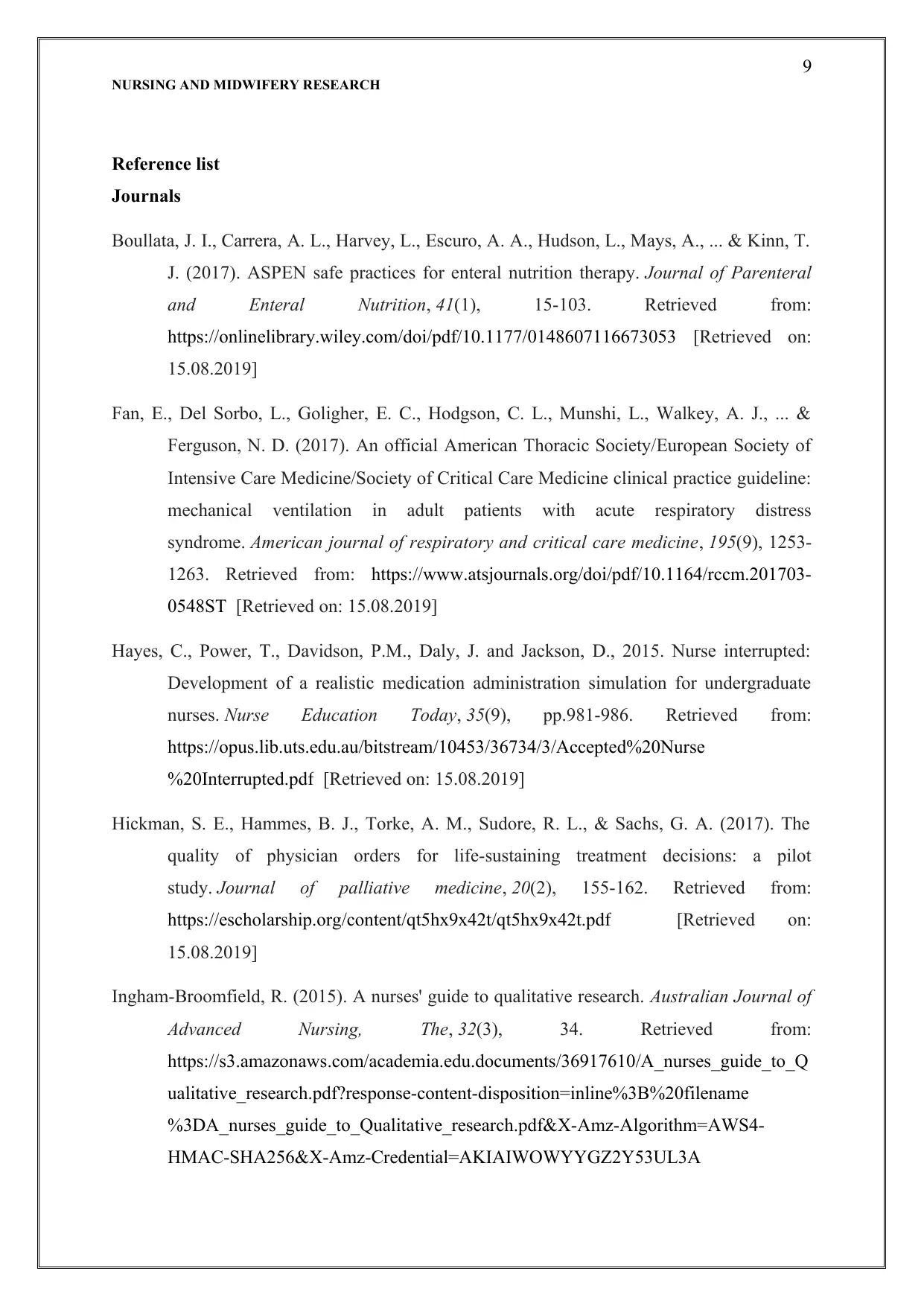
9
NURSING AND MIDWIFERY RESEARCH
Reference list
Journals
Boullata, J. I., Carrera, A. L., Harvey, L., Escuro, A. A., Hudson, L., Mays, A., ... & Kinn, T.
J. (2017). ASPEN safe practices for enteral nutrition therapy. Journal of Parenteral
and Enteral Nutrition, 41(1), 15-103. Retrieved from:
https://onlinelibrary.wiley.com/doi/pdf/10.1177/0148607116673053 [Retrieved on:
15.08.2019]
Fan, E., Del Sorbo, L., Goligher, E. C., Hodgson, C. L., Munshi, L., Walkey, A. J., ... &
Ferguson, N. D. (2017). An official American Thoracic Society/European Society of
Intensive Care Medicine/Society of Critical Care Medicine clinical practice guideline:
mechanical ventilation in adult patients with acute respiratory distress
syndrome. American journal of respiratory and critical care medicine, 195(9), 1253-
1263. Retrieved from: https://www.atsjournals.org/doi/pdf/10.1164/rccm.201703-
0548ST [Retrieved on: 15.08.2019]
Hayes, C., Power, T., Davidson, P.M., Daly, J. and Jackson, D., 2015. Nurse interrupted:
Development of a realistic medication administration simulation for undergraduate
nurses. Nurse Education Today, 35(9), pp.981-986. Retrieved from:
https://opus.lib.uts.edu.au/bitstream/10453/36734/3/Accepted%20Nurse
%20Interrupted.pdf [Retrieved on: 15.08.2019]
Hickman, S. E., Hammes, B. J., Torke, A. M., Sudore, R. L., & Sachs, G. A. (2017). The
quality of physician orders for life-sustaining treatment decisions: a pilot
study. Journal of palliative medicine, 20(2), 155-162. Retrieved from:
https://escholarship.org/content/qt5hx9x42t/qt5hx9x42t.pdf [Retrieved on:
15.08.2019]
Ingham-Broomfield, R. (2015). A nurses' guide to qualitative research. Australian Journal of
Advanced Nursing, The, 32(3), 34. Retrieved from:
https://s3.amazonaws.com/academia.edu.documents/36917610/A_nurses_guide_to_Q
ualitative_research.pdf?response-content-disposition=inline%3B%20filename
%3DA_nurses_guide_to_Qualitative_research.pdf&X-Amz-Algorithm=AWS4-
HMAC-SHA256&X-Amz-Credential=AKIAIWOWYYGZ2Y53UL3A
NURSING AND MIDWIFERY RESEARCH
Reference list
Journals
Boullata, J. I., Carrera, A. L., Harvey, L., Escuro, A. A., Hudson, L., Mays, A., ... & Kinn, T.
J. (2017). ASPEN safe practices for enteral nutrition therapy. Journal of Parenteral
and Enteral Nutrition, 41(1), 15-103. Retrieved from:
https://onlinelibrary.wiley.com/doi/pdf/10.1177/0148607116673053 [Retrieved on:
15.08.2019]
Fan, E., Del Sorbo, L., Goligher, E. C., Hodgson, C. L., Munshi, L., Walkey, A. J., ... &
Ferguson, N. D. (2017). An official American Thoracic Society/European Society of
Intensive Care Medicine/Society of Critical Care Medicine clinical practice guideline:
mechanical ventilation in adult patients with acute respiratory distress
syndrome. American journal of respiratory and critical care medicine, 195(9), 1253-
1263. Retrieved from: https://www.atsjournals.org/doi/pdf/10.1164/rccm.201703-
0548ST [Retrieved on: 15.08.2019]
Hayes, C., Power, T., Davidson, P.M., Daly, J. and Jackson, D., 2015. Nurse interrupted:
Development of a realistic medication administration simulation for undergraduate
nurses. Nurse Education Today, 35(9), pp.981-986. Retrieved from:
https://opus.lib.uts.edu.au/bitstream/10453/36734/3/Accepted%20Nurse
%20Interrupted.pdf [Retrieved on: 15.08.2019]
Hickman, S. E., Hammes, B. J., Torke, A. M., Sudore, R. L., & Sachs, G. A. (2017). The
quality of physician orders for life-sustaining treatment decisions: a pilot
study. Journal of palliative medicine, 20(2), 155-162. Retrieved from:
https://escholarship.org/content/qt5hx9x42t/qt5hx9x42t.pdf [Retrieved on:
15.08.2019]
Ingham-Broomfield, R. (2015). A nurses' guide to qualitative research. Australian Journal of
Advanced Nursing, The, 32(3), 34. Retrieved from:
https://s3.amazonaws.com/academia.edu.documents/36917610/A_nurses_guide_to_Q
ualitative_research.pdf?response-content-disposition=inline%3B%20filename
%3DA_nurses_guide_to_Qualitative_research.pdf&X-Amz-Algorithm=AWS4-
HMAC-SHA256&X-Amz-Credential=AKIAIWOWYYGZ2Y53UL3A
⊘ This is a preview!⊘
Do you want full access?
Subscribe today to unlock all pages.

Trusted by 1+ million students worldwide
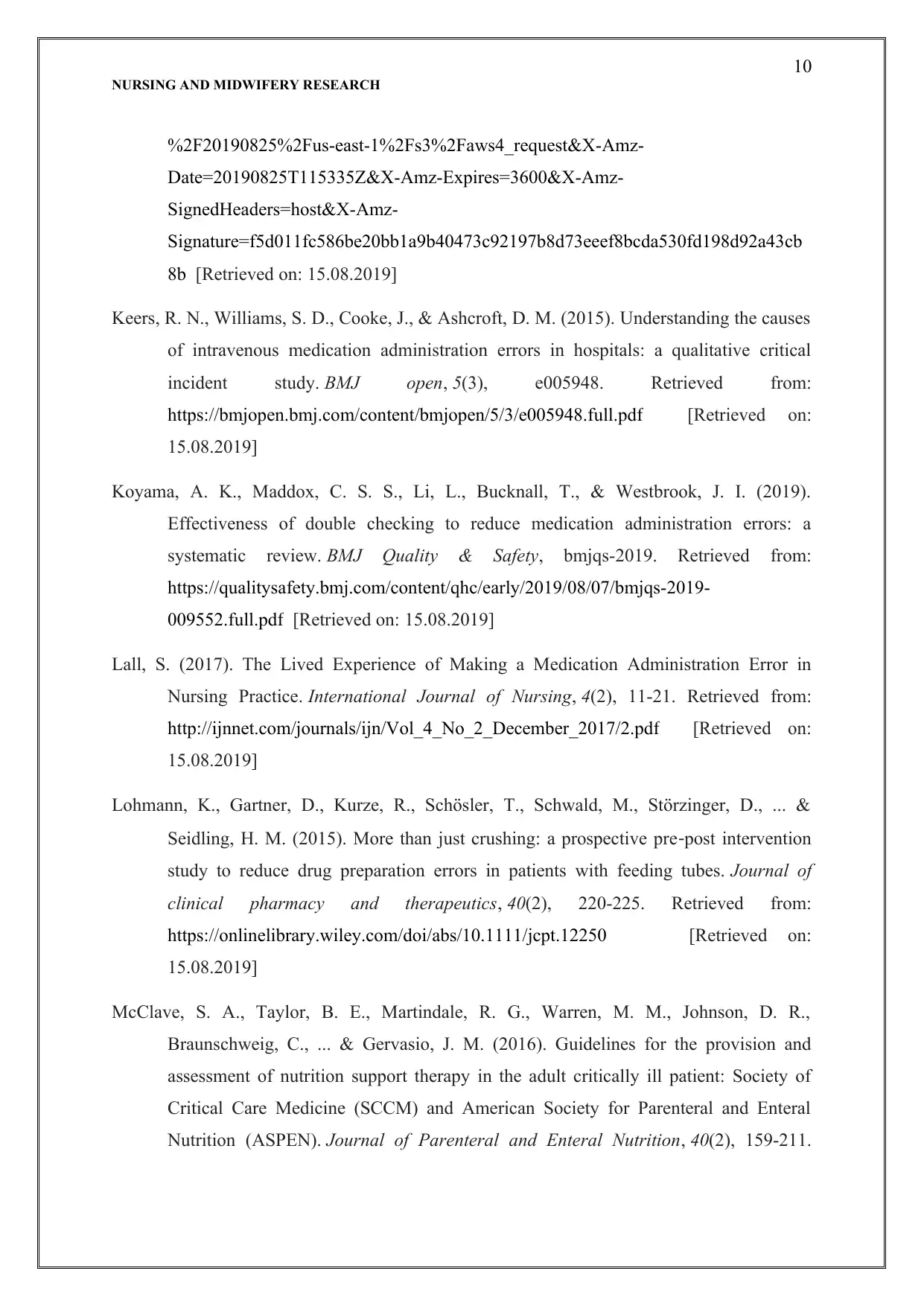
10
NURSING AND MIDWIFERY RESEARCH
%2F20190825%2Fus-east-1%2Fs3%2Faws4_request&X-Amz-
Date=20190825T115335Z&X-Amz-Expires=3600&X-Amz-
SignedHeaders=host&X-Amz-
Signature=f5d011fc586be20bb1a9b40473c92197b8d73eeef8bcda530fd198d92a43cb
8b [Retrieved on: 15.08.2019]
Keers, R. N., Williams, S. D., Cooke, J., & Ashcroft, D. M. (2015). Understanding the causes
of intravenous medication administration errors in hospitals: a qualitative critical
incident study. BMJ open, 5(3), e005948. Retrieved from:
https://bmjopen.bmj.com/content/bmjopen/5/3/e005948.full.pdf [Retrieved on:
15.08.2019]
Koyama, A. K., Maddox, C. S. S., Li, L., Bucknall, T., & Westbrook, J. I. (2019).
Effectiveness of double checking to reduce medication administration errors: a
systematic review. BMJ Quality & Safety, bmjqs-2019. Retrieved from:
https://qualitysafety.bmj.com/content/qhc/early/2019/08/07/bmjqs-2019-
009552.full.pdf [Retrieved on: 15.08.2019]
Lall, S. (2017). The Lived Experience of Making a Medication Administration Error in
Nursing Practice. International Journal of Nursing, 4(2), 11-21. Retrieved from:
http://ijnnet.com/journals/ijn/Vol_4_No_2_December_2017/2.pdf [Retrieved on:
15.08.2019]
Lohmann, K., Gartner, D., Kurze, R., Schösler, T., Schwald, M., Störzinger, D., ... &
Seidling, H. M. (2015). More than just crushing: a prospective pre‐post intervention
study to reduce drug preparation errors in patients with feeding tubes. Journal of
clinical pharmacy and therapeutics, 40(2), 220-225. Retrieved from:
https://onlinelibrary.wiley.com/doi/abs/10.1111/jcpt.12250 [Retrieved on:
15.08.2019]
McClave, S. A., Taylor, B. E., Martindale, R. G., Warren, M. M., Johnson, D. R.,
Braunschweig, C., ... & Gervasio, J. M. (2016). Guidelines for the provision and
assessment of nutrition support therapy in the adult critically ill patient: Society of
Critical Care Medicine (SCCM) and American Society for Parenteral and Enteral
Nutrition (ASPEN). Journal of Parenteral and Enteral Nutrition, 40(2), 159-211.
NURSING AND MIDWIFERY RESEARCH
%2F20190825%2Fus-east-1%2Fs3%2Faws4_request&X-Amz-
Date=20190825T115335Z&X-Amz-Expires=3600&X-Amz-
SignedHeaders=host&X-Amz-
Signature=f5d011fc586be20bb1a9b40473c92197b8d73eeef8bcda530fd198d92a43cb
8b [Retrieved on: 15.08.2019]
Keers, R. N., Williams, S. D., Cooke, J., & Ashcroft, D. M. (2015). Understanding the causes
of intravenous medication administration errors in hospitals: a qualitative critical
incident study. BMJ open, 5(3), e005948. Retrieved from:
https://bmjopen.bmj.com/content/bmjopen/5/3/e005948.full.pdf [Retrieved on:
15.08.2019]
Koyama, A. K., Maddox, C. S. S., Li, L., Bucknall, T., & Westbrook, J. I. (2019).
Effectiveness of double checking to reduce medication administration errors: a
systematic review. BMJ Quality & Safety, bmjqs-2019. Retrieved from:
https://qualitysafety.bmj.com/content/qhc/early/2019/08/07/bmjqs-2019-
009552.full.pdf [Retrieved on: 15.08.2019]
Lall, S. (2017). The Lived Experience of Making a Medication Administration Error in
Nursing Practice. International Journal of Nursing, 4(2), 11-21. Retrieved from:
http://ijnnet.com/journals/ijn/Vol_4_No_2_December_2017/2.pdf [Retrieved on:
15.08.2019]
Lohmann, K., Gartner, D., Kurze, R., Schösler, T., Schwald, M., Störzinger, D., ... &
Seidling, H. M. (2015). More than just crushing: a prospective pre‐post intervention
study to reduce drug preparation errors in patients with feeding tubes. Journal of
clinical pharmacy and therapeutics, 40(2), 220-225. Retrieved from:
https://onlinelibrary.wiley.com/doi/abs/10.1111/jcpt.12250 [Retrieved on:
15.08.2019]
McClave, S. A., Taylor, B. E., Martindale, R. G., Warren, M. M., Johnson, D. R.,
Braunschweig, C., ... & Gervasio, J. M. (2016). Guidelines for the provision and
assessment of nutrition support therapy in the adult critically ill patient: Society of
Critical Care Medicine (SCCM) and American Society for Parenteral and Enteral
Nutrition (ASPEN). Journal of Parenteral and Enteral Nutrition, 40(2), 159-211.
Paraphrase This Document
Need a fresh take? Get an instant paraphrase of this document with our AI Paraphraser
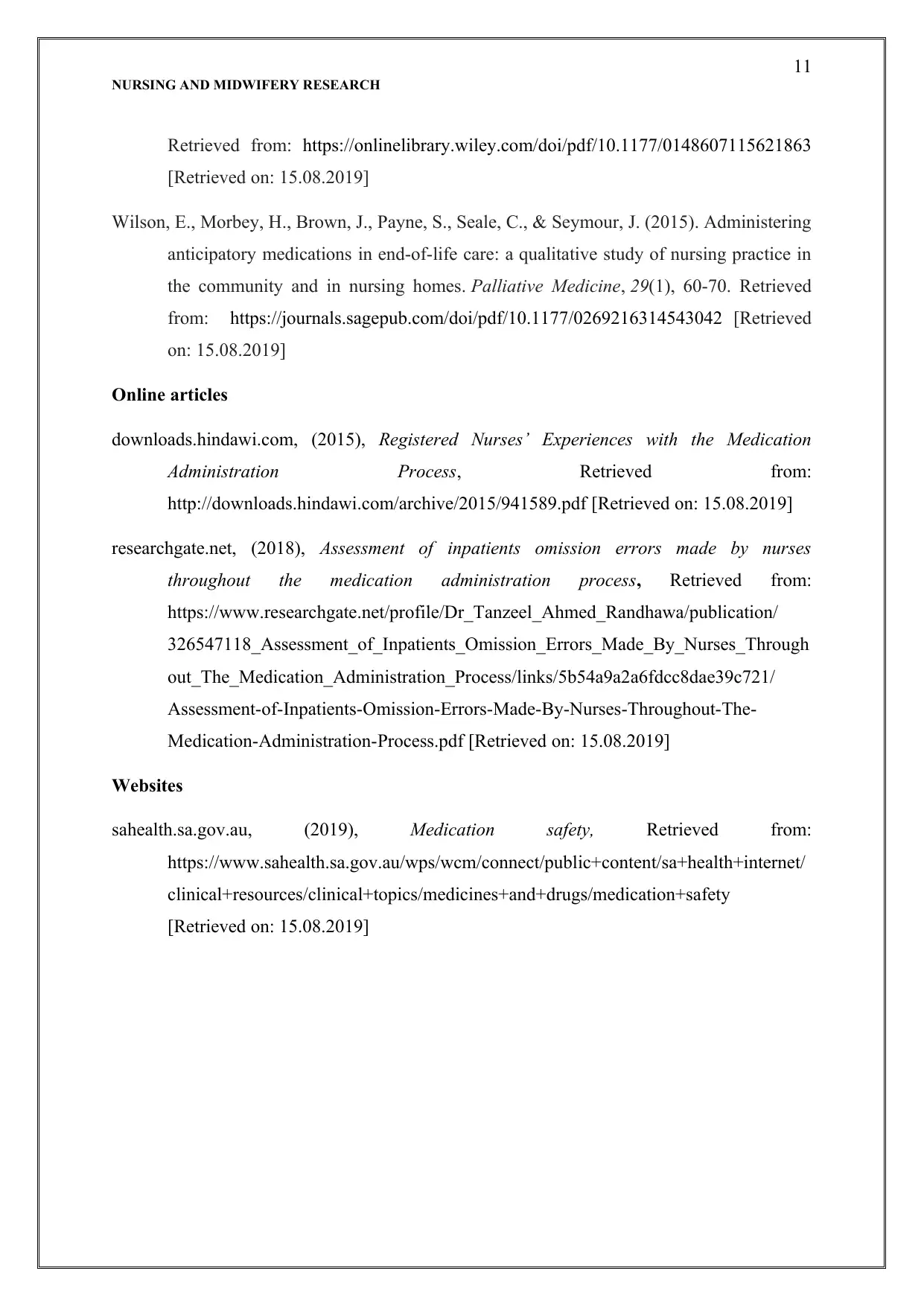
11
NURSING AND MIDWIFERY RESEARCH
Retrieved from: https://onlinelibrary.wiley.com/doi/pdf/10.1177/0148607115621863
[Retrieved on: 15.08.2019]
Wilson, E., Morbey, H., Brown, J., Payne, S., Seale, C., & Seymour, J. (2015). Administering
anticipatory medications in end-of-life care: a qualitative study of nursing practice in
the community and in nursing homes. Palliative Medicine, 29(1), 60-70. Retrieved
from: https://journals.sagepub.com/doi/pdf/10.1177/0269216314543042 [Retrieved
on: 15.08.2019]
Online articles
downloads.hindawi.com, (2015), Registered Nurses’ Experiences with the Medication
Administration Process, Retrieved from:
http://downloads.hindawi.com/archive/2015/941589.pdf [Retrieved on: 15.08.2019]
researchgate.net, (2018), Assessment of inpatients omission errors made by nurses
throughout the medication administration process, Retrieved from:
https://www.researchgate.net/profile/Dr_Tanzeel_Ahmed_Randhawa/publication/
326547118_Assessment_of_Inpatients_Omission_Errors_Made_By_Nurses_Through
out_The_Medication_Administration_Process/links/5b54a9a2a6fdcc8dae39c721/
Assessment-of-Inpatients-Omission-Errors-Made-By-Nurses-Throughout-The-
Medication-Administration-Process.pdf [Retrieved on: 15.08.2019]
Websites
sahealth.sa.gov.au, (2019), Medication safety, Retrieved from:
https://www.sahealth.sa.gov.au/wps/wcm/connect/public+content/sa+health+internet/
clinical+resources/clinical+topics/medicines+and+drugs/medication+safety
[Retrieved on: 15.08.2019]
NURSING AND MIDWIFERY RESEARCH
Retrieved from: https://onlinelibrary.wiley.com/doi/pdf/10.1177/0148607115621863
[Retrieved on: 15.08.2019]
Wilson, E., Morbey, H., Brown, J., Payne, S., Seale, C., & Seymour, J. (2015). Administering
anticipatory medications in end-of-life care: a qualitative study of nursing practice in
the community and in nursing homes. Palliative Medicine, 29(1), 60-70. Retrieved
from: https://journals.sagepub.com/doi/pdf/10.1177/0269216314543042 [Retrieved
on: 15.08.2019]
Online articles
downloads.hindawi.com, (2015), Registered Nurses’ Experiences with the Medication
Administration Process, Retrieved from:
http://downloads.hindawi.com/archive/2015/941589.pdf [Retrieved on: 15.08.2019]
researchgate.net, (2018), Assessment of inpatients omission errors made by nurses
throughout the medication administration process, Retrieved from:
https://www.researchgate.net/profile/Dr_Tanzeel_Ahmed_Randhawa/publication/
326547118_Assessment_of_Inpatients_Omission_Errors_Made_By_Nurses_Through
out_The_Medication_Administration_Process/links/5b54a9a2a6fdcc8dae39c721/
Assessment-of-Inpatients-Omission-Errors-Made-By-Nurses-Throughout-The-
Medication-Administration-Process.pdf [Retrieved on: 15.08.2019]
Websites
sahealth.sa.gov.au, (2019), Medication safety, Retrieved from:
https://www.sahealth.sa.gov.au/wps/wcm/connect/public+content/sa+health+internet/
clinical+resources/clinical+topics/medicines+and+drugs/medication+safety
[Retrieved on: 15.08.2019]
1 out of 11
Related Documents
Your All-in-One AI-Powered Toolkit for Academic Success.
+13062052269
info@desklib.com
Available 24*7 on WhatsApp / Email
![[object Object]](/_next/static/media/star-bottom.7253800d.svg)
Unlock your academic potential
Copyright © 2020–2025 A2Z Services. All Rights Reserved. Developed and managed by ZUCOL.





